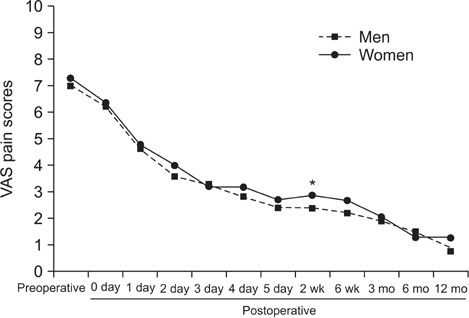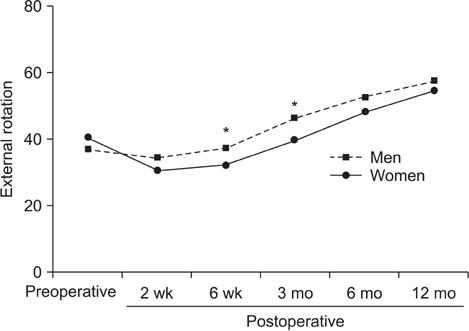Clin Orthop Surg.
2015 Jun;7(2):234-240. 10.4055/cios.2015.7.2.234.
Gender Affects Early Postoperative Outcomes of Rotator Cuff Repair
- Affiliations
-
- 1Department of Orthopedic Surgery, Dongsan Medical Center and Pain Research Center, Keimyung University School of Medicine, Daegu, Korea. oscho5362@dsmc.or.kr
- 2Department of Orthopedic Surgery, Hanmi Hospital, Daegu, Korea.
- KMID: 2164550
- DOI: http://doi.org/10.4055/cios.2015.7.2.234
Abstract
- BACKGROUND
The literature does not provide consistent information on the impact of patients' gender on recovery after rotator cuff repair. The purpose of this study was to determine whether gender affects pain and functional recovery in the early postoperative period after rotator cuff repair.
METHODS
Eighty patients (40 men and 40 women) were prospectively enrolled. Pain intensity and functional recovery were evaluated, using visual analog scale (VAS) pain score and range of motion on each of the first 5 postoperative days, at 2 and 6 weeks and at 3, 6, and 12 months after surgery. Perioperative medication-related adverse effects and postoperative complications were also assessed.
RESULTS
The mean VAS pain score was significantly higher for women than men at 2 weeks after surgery (p = 0.035). For all other periods, there was no significant difference between men and women in VAS pain scores, although women had higher scores than men. Mean forward flexion in women was significantly lower than men at 6 weeks after surgery (p = 0.033) and the mean degree of external rotation in women was significantly lower than men at 6 weeks (p = 0.007) and at 3 months (p = 0.017) after surgery. There was no significant difference in medication-related adverse effects or postoperative complications.
CONCLUSIONS
Women had more pain and slower recovery of shoulder motion than men during the first 3 months after rotator cuff repair. These findings can serve as guidelines for pain management and rehabilitation after surgery and can help explain postoperative recovery patterns to patients with scheduled rotator cuff repair.
Keyword
MeSH Terms
Figure
Reference
-
1. Charousset C, Grimberg J, Duranthon LD, Bellaiche L, Petrover D, Kalra K. The time for functional recovery after arthroscopic rotator cuff repair: correlation with tendon healing controlled by computed tomography arthrography. Arthroscopy. 2008; 24(1):25–33.2. Chung SW, Park JS, Kim SH, Shin SH, Oh JH. Quality of life after arthroscopic rotator cuff repair: evaluation using SF-36 and an analysis of affecting clinical factors. Am J Sports Med. 2012; 40(3):631–639.3. Nho SJ, Shindle MK, Adler RS, Warren RF, Altchek DW, MacGillivray JD. Prospective analysis of arthroscopic rotator cuff repair: subgroup analysis. J Shoulder Elbow Surg. 2009; 18(5):697–704.4. Oh JH, Kim SH, Ji HM, Jo KH, Bin SW, Gong HS. Prognostic factors affecting anatomic outcome of rotator cuff repair and correlation with functional outcome. Arthroscopy. 2009; 25(1):30–39.5. Baysal D, Balyk R, Otto D, Luciak-Corea C, Beaupre L. Functional outcome and health-related quality of life after surgical repair of full-thickness rotator cuff tear using a mini-open technique. Am J Sports Med. 2005; 33(9):1346–1355.6. Robinson PM, Wilson J, Dalal S, Parker RA, Norburn P, Roy BR. Rotator cuff repair in patients over 70 years of age: early outcomes and risk factors associated with re-tear. Bone Joint J. 2013; 95(2):199–205.7. Romeo AA, Hang DW, Bach BR Jr, Shott S. Repair of full thickness rotator cuff tears: gender, age, and other factors affecting outcome. Clin Orthop Relat Res. 1999; (367):243–255.8. Watson EM, Sonnabend DH. Outcome of rotator cuff repair. J Shoulder Elbow Surg. 2002; 11(3):201–211.9. Aubrun F, Salvi N, Coriat P, Riou B. Sex- and age-related differences in morphine requirements for postoperative pain relief. Anesthesiology. 2005; 103(1):156–160.10. Cepeda MS, Carr DB. Women experience more pain and require more morphine than men to achieve a similar degree of analgesia. Anesth Analg. 2003; 97(5):1464–1468.11. Fillingim RB, King CD, Ribeiro-Dasilva MC, Rahim-Williams B, Riley JL 3rd. Sex, gender, and pain: a review of recent clinical and experimental findings. J Pain. 2009; 10(5):447–485.12. Schnabel A, Poepping DM, Gerss J, Zahn PK, Pogatzki-Zahn EM. Sex-related differences of patient-controlled epidural analgesia for postoperative pain. Pain. 2012; 153(1):238–244.13. Taenzer AH, Clark C, Curry CS. Gender affects report of pain and function after arthroscopic anterior cruciate ligament reconstruction. Anesthesiology. 2000; 93(3):670–675.14. Razmjou H, Davis AM, Jaglal SB, Holtby R, Richards RR. Disability and satisfaction after rotator cuff decompression or repair: a sex and gender analysis. BMC Musculoskelet Disord. 2011; 12:66.15. Ochroch EA, Gottschalk A, Troxel AB, Farrar JT. Women suffer more short and long-term pain than men after major thoracotomy. Clin J Pain. 2006; 22(5):491–498.16. Rosseland LA, Stubhaug A. Gender is a confounding factor in pain trials: women report more pain than men after arthroscopic surgery. Pain. 2004; 112(3):248–253.17. Bennett WF. Arthroscopic repair of full-thickness supraspinatus tears (small-to-medium): a prospective study with 2-to 4-year follow-up. Arthroscopy. 2003; 19(3):249–256.18. Manaka T, Ito Y, Matsumoto I, Takaoka K, Nakamura H. Functional recovery period after arthroscopic rotator cuff repair: is it predictable before surgery? Clin Orthop Relat Res. 2011; 469(6):1660–1666.19. Feng S, Guo S, Nobuhara K, Hashimoto J, Mimori K. Prognostic indicators for outcome following rotator cuff tear repair. J Orthop Surg (Hong Kong). 2003; 11(2):110–116.20. O'Holleran JD, Kocher MS, Horan MP, Briggs KK, Hawkins RJ. Determinants of patient satisfaction with outcome after rotator cuff surgery. J Bone Joint Surg Am. 2005; 87(1):121–126.21. Cho CH, Song KS, Min BW, et al. Multimodal approach to postoperative pain control in patients undergoing rotator cuff repair. Knee Surg Sports Traumatol Arthrosc. 2011; 19(10):1744–1748.22. Oh JH, Rhee KY, Kim SH, Lee PB, Lee JW, Lee SJ. Comparison of analgesic efficacy between single interscalene block combined with a continuous intra-bursal infusion of ropivacaine and continuous interscalene block after arthroscopic rotator cuff repair. Clin Orthop Surg. 2009; 1(1):48–53.23. Kamath AF, O'Connor MI. Breakout session: gender and ethnic disparities in pain management. Clin Orthop Relat Res. 2011; 469(7):1962–1966.24. Cho CH, Song KS, Jung GH, Lee YK, Shin HK. Early postoperative outcomes between arthroscopic and mini-open repair for rotator cuff tears. Orthopedics. 2012; 35(9):e1347–e1352.25. Chung SW, Huong CB, Kim SH, Oh JH. Shoulder stiffness after rotator cuff repair: risk factors and influence on outcome. Arthroscopy. 2013; 29(2):290–300.26. Denard PJ, Ladermann A, Burkhart SS. Prevention and management of stiffness after arthroscopic rotator cuff repair: systematic review and implications for rotator cuff healing. Arthroscopy. 2011; 27(6):842–848.27. Oh CH, Oh JH, Kim SH, Cho JH, Yoon JP, Kim JY. Effectiveness of subacromial anti-adhesive agent injection after arthroscopic rotator cuff repair: prospective randomized comparison study. Clin Orthop Surg. 2011; 3(1):55–61.28. Oh JH, Kim SH, Lee HK, Jo KH, Bin SW, Gong HS. Moderate preoperative shoulder stiffness does not alter the clinical outcome of rotator cuff repair with arthroscopic release and manipulation. Arthroscopy. 2008; 24(9):983–991.




